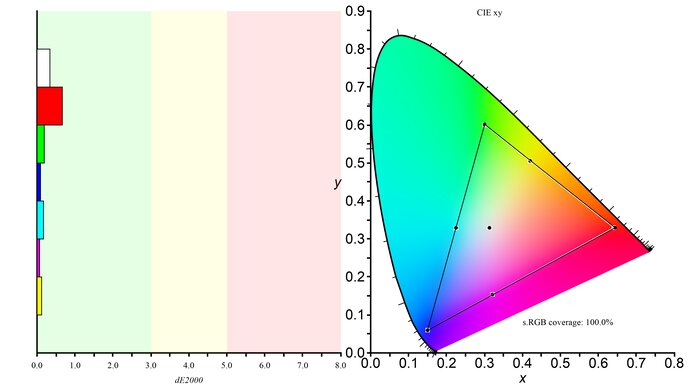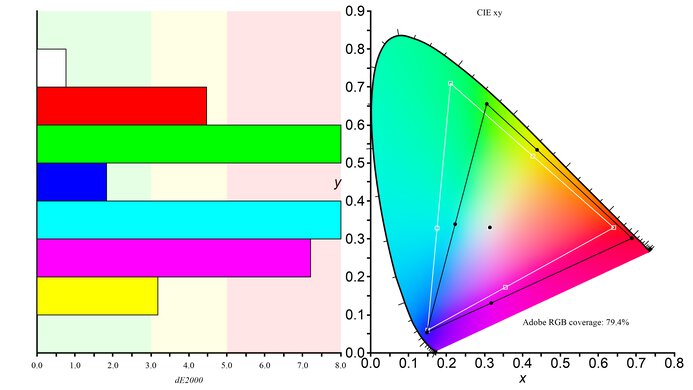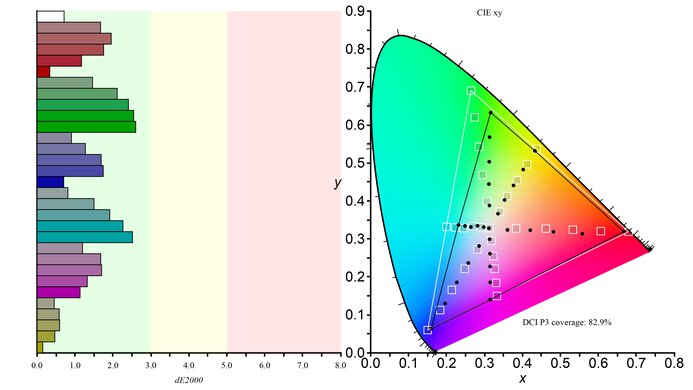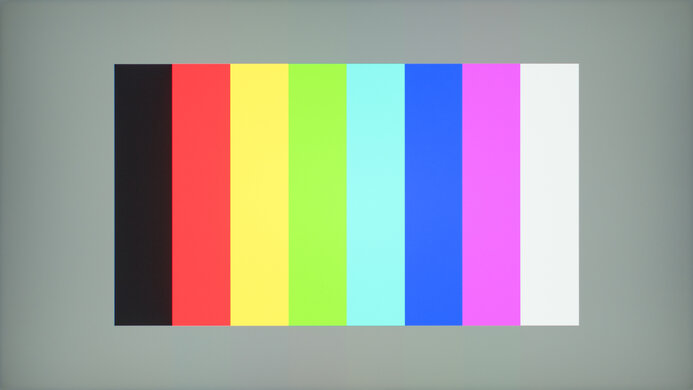The ASUS ROG Strix XG279Q is an excellent gaming monitor packed with extra features. It has Adaptive Sync variable refresh rate (VRR) support that provides both FreeSync and G-SYNC compatibility to reduce screen tearing. Its native 144Hz refresh rate can be overclocked to 170Hz, its response time is remarkable, and it has low input lag, but it increases significantly at 60Hz. The Black Frame Insertion (BFI) feature can be used with VRR enabled, which is a nice addition. The IPS panel offers wide viewing angles, but it has a low contrast ratio and bad black uniformity, so it's not an ideal choice for use in dark rooms. Lastly, it meets its advertised DisplayHDR 400 standards, as it displays a wide color gamut and has decent peak brightness in HDR.
Our Verdict
The ASUS ROG Strix XG279Q is a great monitor for most uses. It offers excellent gaming performance because it has a remarkable response time, VRR support, and incredibly low input lag. Its very good ergonomics, wide viewing angles, and high resolution make it a good choice for office use. It's good for watching movies, but it has a low contrast ratio and bad black uniformity. Lastly, for gaming in HDR, it displays a wide color gamut and gets decently bright, but it also adds a fair amount of input lag.
- Large screen and high resolution.
- Remarkable response time.
- FreeSync and G-SYNC compatibility.
- Decent peak brightness in HDR.
- Uniformity issues.
- Input lag significantly increases at 60Hz.
The ASUS ROG Strix XG279Q is great for office use. It has a large, 27 inch screen that offers enough space to multitask, and the 1440p resolution delivers clear text. It has wide viewing angles if you need to share your screen with others, and the ergonomics are very good. It has significant backlight bleed and some uniformity issues, but this may vary between units. On the upside, reflection handling is great, and it gets bright enough to combat glare.
- Large screen and high resolution.
- Wide viewing angles.
- Good ergonomics.
- Uniformity issues.
The ASUS ROG Strix XG279Q is excellent for gaming. The native 144Hz refresh rate can be overclocked to 170Hz, it's G-SYNC and FreeSync compatible, and its response time is remarkable. The input lag at its max refresh rate is incredibly low, but it increases significantly at 60Hz, so it's not suggested for console gaming. It has an IPS panel with a low contrast ratio, so it's not a good choice for dark-room gaming, but it has wide viewing angles for co-op gaming.
- Remarkable response time.
- FreeSync and G-SYNC compatibility.
- Low input lag at max refresh rate.
- BFI feature can be used with VRR enabled.
- Uniformity issues.
- Low contrast ratio.
The ASUS ROG Strix XG279Q is good for multimedia use. It has a large screen with a high resolution that delivers crisp images. It has great reflection handling, and it gets bright enough to combat glare if you want to use it in a well-lit environment. Its IPS panel provides wide viewing angles, great for watching content with friends. However, it has a low contrast ratio, so blacks appear gray when viewed in the dark.
- Large screen and high resolution.
- Wide viewing angles.
- Good ergonomics.
- Uniformity issues.
- Low contrast ratio.
The ASUS ROG Strix XG279Q is great for content creators. It offers enough screen space to open multiple windows at once, and the 1440p resolution helps deliver crisp images. It has very good ergonomics and wide viewing angles if you need to share your screen with others. Sadly, it has a low contrast ratio and bad black uniformity, so it's not the best option if you work in a dark room. Fortunately, it has great reflection handling and great brightness if you work in a well-lit environment.
- Large screen and high resolution.
- Wide viewing angles.
- Great reflection handling.
- Good ergonomics.
- Uniformity issues.
- Low contrast ratio.
The ASUS ROG Strix XG279Q is decent for HDR gaming. It offers a ton of gaming perks like VRR support, a remarkable response time, and a Black Frame Insertion feature. HDR content looks good because it displays a wide color gamut, but it has a low contrast ratio that makes blacks appear gray, black uniformity is bad, and the input lag is quite high when gaming in HDR.
- Remarkable response time.
- Displays wide color gamut.
- Decent peak brightness in HDR.
- Uniformity issues.
- Low contrast ratio.
- Input lag significantly increases at 60Hz.
Check Price
Differences Between Sizes And Variants
We tested the 27 inch ASUS ROG Strix XG279Q, which is the only size available for this product. However, there are other monitors in the ROG Strix lineup, some of which are listed below.
| Model | Size | Resolution | Panel | Max Refresh Rate | Variable Refresh Rate | Curve | Notes |
| XG279Q | 27" | 1440p | IPS | 170Hz | Adaptive Sync | No | |
| XG27UQ | 27" | 1440p | IPS | 144Hz | Adaptive Sync | No | No ELMB Sync |
| XG32VQR | 32" | 1440p | VA | 144Hz | FreeSync | Yes | |
| XG32VQ | 32" | 1440p | VA | 144Hz | FreeSync | Yes | Mini DisplayPort |
| XG32VC | 32" | 1440p | VA | 170Hz | Adaptive Sync | Yes | |
| XG43VQ | 43" | 3840x1200 | VA | 120Hz | FreeSync | Yes |
If someone comes across a different type of panel or if their ASUS XG279Q doesn't correspond to our review, let us know and we'll update the review. Note that some tests, such as the gray uniformity, may vary between individual units.
The XG279Q we reviewed was manufactured in May 2020, and you can see the label here.
Popular Monitor Comparisons
The ASUS ROG Strix XG279Q has one of the best response times we've seen on any monitor with an IPS panel, and motion remains exceptionally clear even when gaming at 60Hz, which is great. However, its input lag at 60Hz is too high compared to other gaming monitors, such as the LG 27GL850-B/27GL83A-B. Also see our recommendations for the best gaming monitors, the best 144Hz monitors, and the best 1440p monitors.
The ASUS ROG Strix XG279Q is better than the ASUS ROG Swift PG279Q. The XG279Q supports HDR, has a quicker response time, and its max refresh rate is slightly higher. However, the PG279Q has a much lower input lag at 60Hz, it has much better out-of-the-box color accuracy, and wider viewing angles.
The ASUS ROG Strix XG279Q and the ASUS ROG Strix XG27AQ are very similar monitors with similar specs. The biggest difference is that the XG27AQ has a simplified stand, and its local dimming is a little less aggressive. The XG27AQ shows less backlight bleed, resulting in better black uniformity, but this is something that can vary. The XG27AW also has slightly wider viewing angles. The XG279Q, on the other hand, gets brighter overall in SDR and HDR, so it can fight glare a little more easily and can bring out more highlights in HDR content. Otherwise, they perform very similarly and both are among the better gaming monitors we've tested, so you can't really go wrong with either.
The ASUS ROG Strix XG279Q is slightly better than the Dell S2721DGF. The ASUS has a BFI feature, a quicker response time at 60Hz, a slightly higher max refresh rate, and much better color accuracy. However, the Dell has a quicker response time at its max refresh rate and a much lower input lag at 60Hz.
The ASUS ROG Strix XG279Q is better than the LG 27GL850-B/27GL83A-B. The ASUS has much better ergonomics, it gets brighter, there's a BFI feature, and you can overclock its refresh rate to 170Hz. However, the LG has a lower input lag and it has wider viewing angles.

We buy and test more than 30 monitors each year, with units that we buy completely on our own, without any cherry-picked units or samples. We put a lot into each unbiased, straight-to-the-point review, and there's a whole process from purchasing to publishing, involving multiple teams and people. We do more than just use the monitor for a week; we use specialized and custom tools to measure various aspects with objective data-based results. We also consider multiple factors before making any recommendations, including the monitor's cost, its performance against the competition, and whether or not it's easy to find.
Test Results

The ASUS XG279Q has a gamer-oriented design, with lighting on the stand and back. It has a unique tripod stand that's different than most ASUS monitors we've tested. It's well-built, has very thin borders, and has very good ergonomics.
The ergonomics are very good. It allows for a wide range of adjustments, so it should be easy to place it in an ideal viewing position. You can rotate to portrait mode, but only clockwise.
The back panel of the ASUS XG279Q has an etched design with ambient lighting where the brand logo is. It offers cable management through the stand. It can be VESA-mounted, but there's no quick-release button to easily take off the stand.
The ASUS ROG Strix XG279Q has a great build quality. The back panel and stand are both made of sturdy plastic, and the feet are metal. The stand is solid, supports the monitor well, and there's no noticeable wobble. The bottom bezel is a bit flexible, but this shouldn't be too much of an issue. Overall, it's well-made and there aren't any obvious problems with its structure.
Update 10/13/2020: We previously stated this monitor doesn't have a local dimming feature. We corrected the mistake and updated the review.
Like most IPS panels, the ASUS ROG Strix XG279Q has a low contrast ratio, so blacks appear closer to gray when viewed in the dark. Surprisingly, the local dimming feature actually decreases the contrast. It's higher than the advertised 1000:1 contrast, but contrast may vary between units.
Update 10/13/2020: We previously stated this monitor doesn't have a local dimming feature. We corrected the mistake and updated the review.
The ASUS XG279Q has a terrible edge-lit local dimming feature. There are few vertical zones and it doesn't improve the contrast. In SDR, the zone transitions and uniformity are bad, and the local dimming effect is lighter and harder to notice in HDR. The setting to control the feature is called Dynamic Dimming and it can't be used with the Black Frame Insertion feature. It automatically turns on in HDR.
Update 10/13/2020: We previously stated this monitor doesn't have a local dimming feature. We retested SDR peak brightness with local dimming, but it didn't change the results.
The ASUS ROG Strix XG279Q has great peak brightness. It gets bright enough to combat glare, and its brightness remains very consistent across different content, which is great.
We measured peak brightness after calibration with Brightness set to max.
The ASUS Strix XG279Q has decent peak brightness in HDR. It gets bright enough to meet the advertised DisplayHDR 400 standard. It makes some highlights pop in HDR, but it's more noticeable in dark rooms than bright ones. It's fairly consistent across different content, except small areas don't get as bright. We measured peak brightness in 'ASUS Gaming HDR' Picture Mode.
As expected from an IPS panel, the ASUS ROG Strix XG279Q has wide viewing angles. The image remains accurate when viewing from the side, which is good for co-op gaming.
It has okay vertical viewing angles. For the most part, the image remains fairly accurate if you mount the monitor above eye-level, but you may notice a loss in color.
It has excellent gray uniformity. The screen is uniform in the center with no dirty screen effect, but the edges are a bit darker. The uniformity is much better in near-dark scenes. Note that gray uniformity may vary between units.
Update 10/13/2020: We previously stated this monitor doesn't have a local dimming feature. We corrected the mistake and updated the review.
Our unit of the ASUS XG279Q has bad black uniformity, but this may vary between units. There's noticeable clouding throughout and backlight bleed along the edges. The entire screen looks blue-ish/gray. With local dimming enabled, the edges of the screen are darker but there's a lot more blooming around the center cross because of the large, vertical zones, resulting in worse uniformity.
It has great out-of-the-box accuracy. Most colors are only slightly inaccurate, and the color temperature is on the warm side, giving the image a red/yellow tint. White balance is a bit off, and gamma follows the target curve fairly well, except dark scenes are slightly too dark and brighter scenes are a bit too bright. Color accuracy may vary between units.
The ASUS ROG Strix XG279Q has remarkable color accuracy after calibration. Any remaining inaccuracies can't be spotted without the aid of a colorimeter. Gamma follows the target curve better than before calibration, but really bright and really dark scenes are still a bit too bright.
You can download our ICC profile calibration here. This is provided for reference only and shouldn't be used, as the calibration values vary per individual unit even for the same model, due to manufacturing tolerances.
Update 10/13/2020: We previously stated this monitor doesn't have a local dimming feature. We retested SDR color gamut with local dimming, but it didn't change the results.
The ASUS ROG Strix XG279Q has an outstanding SDR color gamut. It has perfect coverage of the commonly-used sRGB color space and good coverage of the wider Adobe RGB color space used in photo editing.
Update 10/13/2020: We previously stated this monitor doesn't have a local dimming feature. We retested SDR color volume with local dimming, but it didn't change the results.
Exceptional color volume. The ASUS XG279Q displays a wide range of colors at different luminance levels, but it has trouble displaying dark, saturated colors well due to the low contrast ratio.
The ASUS XG279Q's HDR color gamut is good. It has great coverage of the DCI P3 color space used in most HDR content, but just okay coverage of the wider Rec. 2020 color space.
Note: The DCI P3 coverage is much lower than the advertised 95% coverage. This is normal and is due to the way we measure DCI P3. We measure DCI P3 by sending a Rec. 2020 signal, but unlike most reviewers, we limit the colors we're sending to the DCI P3 primaries. This results in a lower, but arguably more accurate measurement.
The ASUS ROG Strix XG279Q has a good HDR color volume. It can display a wide range of colors due to its wide color gamut; however, it can't display dark colors well because it has a low contrast ratio.
| Overdrive Setting | Response Time Chart | Response Time Tables | Motion Blur Photo |
| Level 0 | Chart | Table | Photo |
| Level 1 | Chart | Table | Photo |
| Level 2 | Chart | Table | Photo |
| Level 3 | Chart | Table | Photo |
| Level 4 | Chart | Table | Photo |
| Level 5 | Chart | Table | Photo |
The ASUS ROG Strix XG279Q has a remarkable response time at its max refresh rate. Motion looks exceptionally clear with the overdrive setting set to 'Level 2'. There's a bit of overshoot in darker transitions, but it's less than the 'Level 1' and 'Level 3' settings. If overshoot bothers you, 'Level 0' has no overshoot but the response time is slower.
| Overdrive Setting | Response Time Chart | Response Time Tables | Motion Blur Photo |
| Level-0 | Chart | Table | Photo |
| Level 1 | Chart | Table | Photo |
| Level 2 | Chart | Table | Photo |
| Level 3 | Chart | Table | Photo |
| Level 4 | Chart | Table | Photo |
| Level 5 | Chart | Table | Photo |
The ASUS XG279Q's response time at 60Hz is incredible. Unlike at its max refresh rate, the recommended overdrive setting is 'Level 0', so you may have to change the overdrive setting if the frame rate of your game drops. There's too much overshoot in the higher settings, resulting in ghosting behind fast-moving objects.
Update 02/1/2022: A user pointed out that the monitor appears to use pulse width modulation to dim the screen when playing HDR content. We tested it and found that the screen flickers at 240Hz whenever it's receiving an HDR signal with the white point set to less than 500 cd/m², even if the content itself is in SDR. This occurs when Windows HDR is enabled, as Windows sets the white point to a low level. This isn't an issue when playing games, as long as you set the white point in the game to anything above 500 cd/m². The flicker varies between local dimming zones, which can be very distracting. For example, if you're watching a video in HDR on one side of the screen and browsing the web on the other, the side of the screen playing the video will be flicker-free, whereas the other side will flicker at 240Hz.
The backlight is completely flicker-free when displaying SDR content, which helps reduce eye strain. Unfortunately, it flickers at 240Hz when playing some content in HDR, which can be distracting.
The ASUS ROG Strix XG279Q has an optional Black Frame Insertion feature to reduce motion blur. It's called ELMB Sync, and it works with VRR enabled, which most monitors can't do. However, with VRR and ELMB Sync enabled, you can't adjust the overdrive setting.
The ASUS ROG Strix XG279Q has a native 144Hz refresh rate that can be overclocked to 170Hz over a DisplayPort connection. G-SYNC only works over a DisplayPort connection, and over HDMI, the max refresh rate is 144Hz.
The ASUS ROG Strix XG279Q has an incredibly low input lag at its max refresh rate of 170Hz. Similar to the ASUS VG279QM, the input lag significantly increases at 60Hz. The refresh rate is limited to 60Hz in HDR over an HDMI connection, which is why it has a high input lag. BFI input lag was measured at 165Hz.
The ASUS ROG Strix XG279Q has a great size, allowing you to open multiple windows at once. The high resolution helps deliver clear and crisp images.
Update 03/22/2021: We incorrectly listed that there was only one USB input, when there are two. The review has been updated.
The ASUS XG279Q has a ton of extra features:
- Lighting: You can set the bias lighting on the back panel and stand to different preset colors and modes. If you download the Aura Sync Utility software, you can synchronize its lighting effects with other Aura-compatible devices.
- Shadow Boost: Makes objects in dark areas more visible.
- GameVisual: Seven pre-set picture modes.
- GamePlus: Includes virtual crosshairs, FPS counter, and display alignment.
- Ultra-Low Blue Light Technology: Removes blue light to help reduce eye strain.




















































